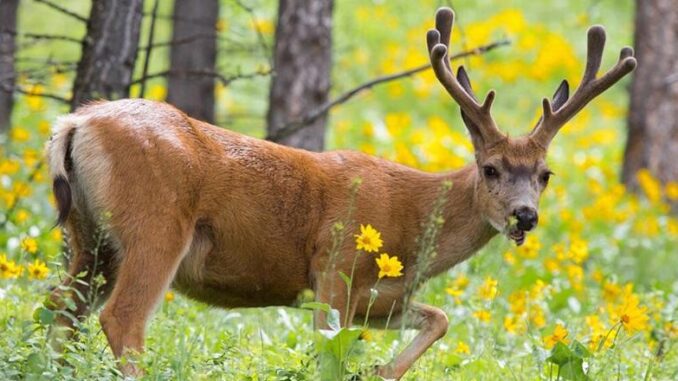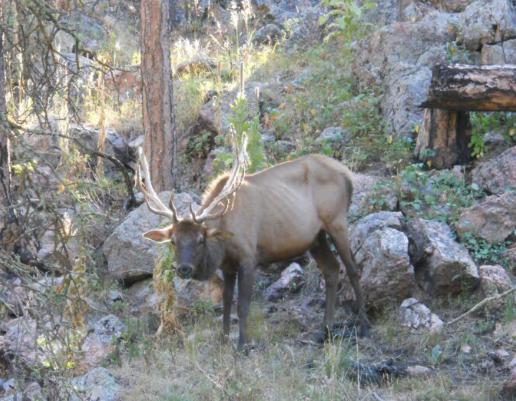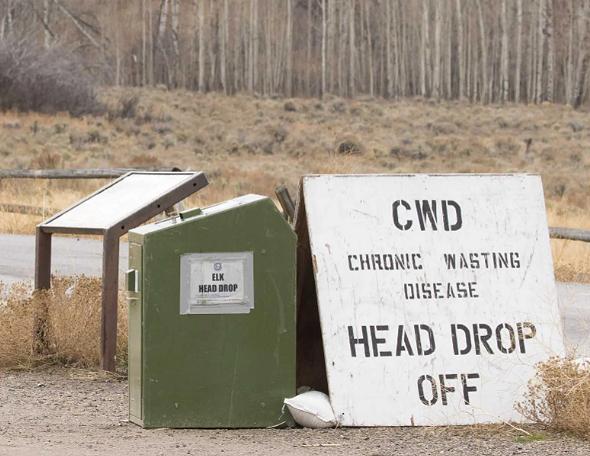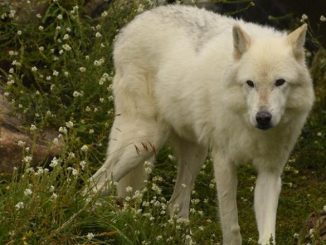
MAMMOTH HOT SPRINGS, Wyoming, December 29, 2023 (ENS) – Yellowstone National Park and the Wyoming Game and Fish Department have confirmed the presence of chronic wasting disease, CWD, in the carcass of an adult mule deer buck found near Yellowstone Lake in the southeastern section of the park. Chronic wasting disease is 100 percent fatal to infected deer, elk and moose.
Announced in November, this is the first confirmed detection of the disease in Yellowstone National Park.
The infected mule deer, also called blacktail deer, was originally captured by Wyoming Game and Fish staff near Cody, Wyoming in March 2023 as part of a population dynamics study and fitted with a GPS collar. The collar signaled the animal died mid-October 2023.
In coordination with Yellowstone staff, Wyoming Game and Fish located the carcass on the Promontory, a landmass that separates the South and Southeast arms of Yellowstone Lake and collected samples for testing. The samples tested positive for CWD based on multiple diagnostic tests performed at Wyoming Game and Fish’s Wildlife Health Laboratory.
Yellowstone staff will prioritize the following actions to manage the disease as there is no effective strategy to eradicate it once established.
- – Increase collaboration and information sharing with Wyoming Game and Fish and other state agencies to identify areas within Yellowstone with increased risk for CWD.
- – Increase monitoring for the presence of CWD in other deer, elk and moose in the park.
- – Increase the investigation of carcasses and collection of samples for testing.
Also in November, Wyoming Game and Fish staff confirmed the presence of chronic wasting disease in a cow elk in Elk Hunt Area 92 in Wyoming’s Pinedale Region it shares a small border with Elk Hunt Area 98 to the south where CWD was detected in 2021.
To ensure hunters are informed, Game and Fish announces whenever CWD is found in a new hunt area.

The Centers for Disease Control recommends that hunters do not consume any animal that is obviously ill or tests positive for CWD.
Continued monitoring of CWD over time is important to help Game and Fish understand the potential impacts of the disease as well as evaluate future management actions for deer and elk.
An interactive map of CWD endemic areas is available on the Wyoming Game and Fish website.
The U.S. Centers for Disease Control and Prevention reported that “as of November 2023, CWD in free-ranging deer, elk and/or moose has been reported in at least 31 states in the continental United States, as well as three provinces in Canada.”
For a map of North America showing the current distribution of chronic wasting disease across the continent, click here.
Cases have also been reported in Norway, Finland, Sweden and South Korea.
No Treatment Known for Chronic Wasting Disease
CWD is a contagious, fatal disease of deer, elk and moose caused by a malformed protein (prion) for which there is no vaccine or known treatment.
The malformed prion accumulates in the brain and other tissues causing physiological and behavioral changes, emaciation and death.
The Mule Deer Foundation explains that chronic wasting disease is one of a family of diseases called transmissible spongiform encephalopathies similar to mad cow disease in cattle, scrapie in sheep, and Creutzfeldt-Jakob disease in humans.
Signs of CWD include listlessness, weight loss, increased drinking and urinating, excessive drooling and head lowering.
It is transmitted by direct animal-to-animal contact or indirectly through contact with infectious particles persisting in the environment such as feces, soil or vegetation.
Since the mid-1980s, CWD has spread across Wyoming and is now found in most of the state.
About 10-15 percent of the mule deer near Cody, Wyoming, that migrate into the southeast portion of Yellowstone during summer months are estimated to have CWD. The long-term effect of CWD on deer, elk and moose in the Yellowstone area is uncertain.
In 2022, Wyoming Game and Fish personnel tested 6,701 CWD lymph node samples from deer, elk and moose, primarily submitted by hunters.

Guidance for Yellowstone Park Visitors
Most wild animals in Yellowstone are healthy and thrive in their natural environment, but sometimes wildlife can get sick.
Early detection is critical to slowing the spread of this disease, which can be transmitted through direct contact between animals such as shared body fluids or from plants and soil in a contaminated area. Infected deer can transmit the disease even if they are not currently showing symptoms.
If visitors see any sick or dead wildlife, they should notify a National Park Service employee as soon as possible and avoid contact with the animal. Avoid touching or handling sick or dead wild animals as some disease-causing organisms can be passed between wild animals and people.
There is currently no evidence that CWD can infect humans or domestic animal species. However, the National Park Service recommends that tissues from CWD-infected animals not be consumed.
“To date, there have been no reported cases of CWD infection in people,” according to the U.S. Centers for Disease Control and Prevention. “However, some animal studies suggest CWD poses a risk to certain types of non-human primates, like monkeys, that eat meat from CWD-infected animals or come in contact with brain or body fluids from infected deer or elk. These studies raise concerns that there may also be a risk to people.”
Since 1997, the World Health Organization has recommended that it is important to keep the agents of all known prion diseases from entering the human food chain.
NPS employees trained in wildlife health use specific protective measures to safely deal with a wild animal that may have died of disease.
Most CWD-positive animals in wild populations don’t show clinical signs of the disease until its very late stages. If hunting in a CWD region, it is critical to get your deer tested even if they do not have any appearance of being sick, the Mule Deer Foundation advises.
Yellowstone is currently revising its 2021 Chronic Wasting Disease Surveillance Plan due to the recent detection and anticipate completion of the new Plan in 2024.
Chronic Wasting Disease Still Spreading
Since its discovery in the late 1960s in Colorado, CWD has spread to more than half the states in the United States, including six of seven states bordering Kentucky – Missouri, Illinois, Ohio, West Virginia, Virginia, and Tennessee – but Kentucky itself was CWD-free until this month.
On December 7, Kentucky Department of Fish and Wildlife Resources officials announced that tissue collected from a 2½-year-old male white-tailed deer harvested by a hunter in Ballard County in November had tested positive for the fatal disease.
”We at Kentucky Fish and Wildlife hoped this day would never come but we have been preparing for it,” Kentucky Fish and Wildlife Commissioner Rich Storm said. “Our team of experts first developed our CWD Response Plan more than 20 years ago, and it has been enhanced through the years using the best available science.”
“Collaboration with our many partners, including hunters, taxidermists, meat processors, diagnostic testing facilities and other government agencies has enhanced our CWD surveillance efforts,” Storm said.
Biologists collected tissue from the animal as part of Kentucky’s ongoing CWD surveillance efforts. Since 2002, Kentucky Fish and Wildlife has CWD-tested more than 40,000 deer and elk from across the state, sampling every county.
“Although CWD is always fatal to infected individual animals,” Storm said, “by following best practices we can minimize its impact on the long-term health and sustainability of our deer herd so that we can continue to enjoy our deer and elk herds for many generations to come.”
Featured image: Mule deer, pictured here, are common in Yellowstone National Park, living throughout the park in almost all habitats. White-tailed deer are scarce and live along streams in the northern range. undated. (Photo by Neal Herbert courtesy National Park Service)



